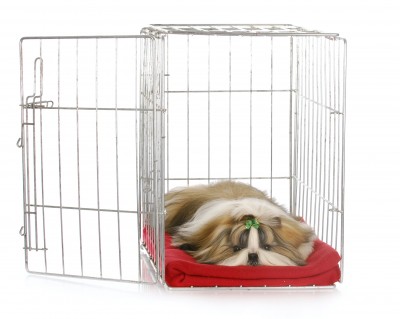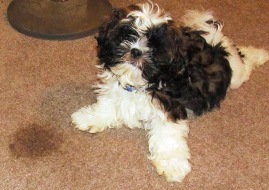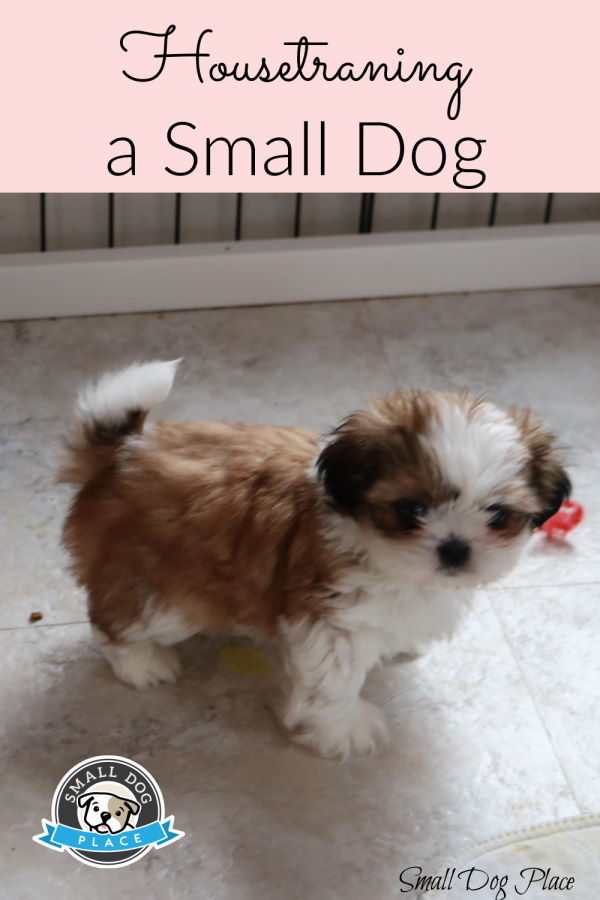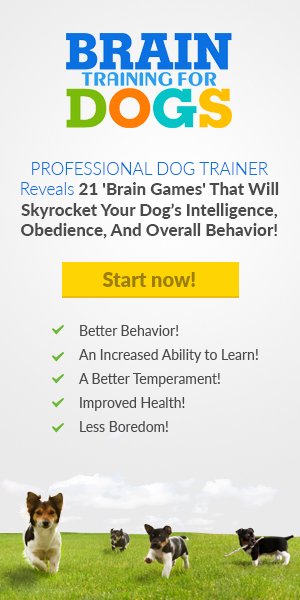- Small Dog Place Home
- Training
- Housetraining
House Training a Small Breed Dog: You Can Do It!
By Janice Jones |Last Updated 06/07/2022
Have you heard people say, “House training a small dog is impossible—better to get a big dog, they’re much easier!”
There is some element of truth to that statement in that some small dogs are harder to train than larger dogs.
It doesn’t have to be an impossible chore. The time you spend in housebreaking and training a small dog, whether she is a puppy or adult will be the best investment you can make.
Unless you plan to confine your little
dog to a small portion of your home forever, she will need to learn where and
when to eliminate. Confining your dog is your decision, but if you want a
pet that you can keep in a small area, a guinea pig or hamster, not a dog might
work.
Your well-trained puppy becomes a treasured member of your family and true companion.
When you feel confident that your dog is not likely to mess in the house, you will feel freer traveling and visiting friends with your loyal canine companion feel self-assured that you will be welcomed time and again.
Did you know that one of the reasons people relinquish their dogs to rescues or shelters involves housebreaking problems, although most will not admit this?
The last thing on your mind for your beloved and cherished pet is a rescue, so read on and sees how this whole training thing works.
House Training Puppies Vs. Adult Small Dogs
Basically training an adult and a puppy is similar with a few main distinctions.
Puppies have small bladders, and when they have to go, THEY HAVE TO GO. Adults are able to hold it longer.
Puppies who come from breeders who have already started housebreaking are easier to train than those from other sources.
Puppies from pet stores are probably the hardest group of dogs to housebreak. Living their entire young life in a cage has prevented them from using their natural desires to keep their den clean. They give up.
Adult dogs can be trained, but it might take longer than puppies.
Patience and consistency are key elements of any good training program.
When To Start House Training
A puppy should be started on house training the minute you bring him home. Ideally you will already have set supplies and equipment in place and ready to use. A little more about the must-haves for potty-training your dog are listed below.
You will have already read this article or other related articles and have a general idea what you will need to do.
Decisions, Decisions!
Make those choices before the House Training Begins
Where's the Doggie Bathroom?
You will have decided where you want the dog to do his business (inside on pads, paper, or something similar) or outdoors.
If you choose outdoors, which most people do, then you will need to decide if the dog will have free access to your entire yard or whether you prefer that a certain section be designated as the canine “bathroom.”
Initially, potty training goes much faster if you take the puppy to the same spot in the yard each time. The scents in that area will remind him what he is supposed to be doing.
You're Asking Me to Do What?
Dog trainers use words, hand signals and treats to mold behavior. House training can use these methods with great results. There are standard words that many people use when teaching a behavior such as “sit, down, stay and wait.”
I think with house training; you will need to come up with the terms you feel most comfortable using. They can be anything that you can say in public and feel reasonably comfortable knowing that they may be words you will use for the entire lifetime of the puppy. Decide on these words before you start to train.
I use words such as go pee-pee and poop-poop, but you have to understand that those are words I’ve used with my own children and those I’ve taught over my 30 plus years as a childhood educator. You might say, “do your business, or go potty, or hurry up,” whatever works for you.
Doggie Behavior 101:
I’m telling you I gotta go
If you have never had a dog before or if it has been some time, you will want to brush up on puppy body language. Luckily for us, puppies and older dogs are fairly consistent from breed to breed on how they show the world that it is time to potty.
Dogs do what I call the potty dance. They will sniff the ground, first moving in larger circles then smaller circles until they find the perfect place, squat and do their business. Both boy and girl puppies squat to urinate. Most male puppies do not begin lifting their leg until they are about 6 months or older.
But, for house training to be a success, you need to know how to read those important signs. The best way to do this is to spend time observing the puppy. In other words, don’t let him out of your sight.
Not all puppies will consistently do the potty dance, so you will need to know the signals your puppy uses right before he squats. Now you’re probably saying to yourself at this point,

“This doesn’t sound very hard; after all, what could be more fun than to watch a new puppy!”
It is fun, but we can’t do this 24/7 and that is where the crate comes into play. A crate is cage or carrier that is big enough for a puppy or adult to go in willingly, stand up, turn around and stretch out fully. It is not so big that it doubles as a bedroom and bathroom.
One big mistake that many small dog owners make is to buy a crate that is too large whereby allowing the puppy to enjoy an afternoon snooze and then get up and move to the other side of the crate where he does his pottying. If you are planning to use a crate, read our article on crate training small dogs.
Does he understand what to do? Will he obligingly eliminate where you tell him? The answer is simple: Perhaps, but probably not every time! At first we are capitalizing on the puppy’s innate need to keep his den (crate) clean.
Puppies also learn a great deal from other canines at this age. First, they learn from their mom and litter-mates. When they go to their new homes, they observe the habits of the resident dog or dogs if there are any. If the puppy has had a good early upbringing, he will follow his mother and copy what she does.
So, you decided where the puppy will urinate and defecate, chose the command words that you will use, purchased all the must-haves and set up a crate and a small room or x-pen. Now what?
Must He Stay in the Crate All of the Time?
I'm sure you didn't get a puppy so you could keep him in a cage and if you did, that would be cruel. The crate is used for his bed and safe place, but keeping the puppy in there too long will be counterproductive.
The crate is useful when you can't give your puppy your full attention.
Alternatives to the Crate or Pen
One possible solution to keeping the puppy in the crate is to keep him on a leash. One end of the leash is attached to his collar or harness and the other end of the leash is attached to you. The easiest way to accomplish this is to purchase a clip that will attach the leash to your belt or belt loop.
Potty Schedules
Scheduling and consistency is very important in potty or house training your new pup. Young puppies will naturally need to eliminate after certain events:
- After he eats or drinks
- After he plays
- After he sleeps
- At other times, at least every 1 ½ to 2 hours
The most successful house training methods urge you to arrange your schedule so that you will have time for house-training your pup right from the start. If you know you will be getting a new dog, see if you will be able to arrange a few days off from work or at least a weekend of nonstop house-training!
This doesn't mean a week of vacationing, TV binge watching, or trying out that new video game. It does mean watching your puppy.
Feeding Schedules
Regular feeding schedules help speed up the process of house training. Young puppies need to eat about 3 times a day and feeding at regular times will keep the puppy on a potty schedule.
Water should be available throughout the day. They don't need to have free access to water all night long and I would recommend you take the water up an hour or more before you go to bed.
If you simply can’t feed the midday meal, leave some dry kibble available. Very small puppies are prone to hypoglycemia if they go too long with food.
Night Time Rituals
Expect the first few nights to be sleepless ones. Nighttime can be problematic because many small puppies cannot sleep through the night without the need to go. This means getting up in the middle of the night to take your puppy out.
Remember you’re a mama or papa now. Some equate the acquisition of a new puppy to that of a newborn, and there is much truth to this. Expect this to happen and then be pleasantly surprised if the puppy sleeps straight through the night. It does happen.
Procedures
Take the puppy to where you have designated and wait. I have found that walking slowly around in small circles gives some puppies a clue, but not all. If the puppy starts to play and has no indication of doing anything, pick him up and bring him indoors. Place him back in the crate or x-pen. No negativity at this point.
If the puppy goes, act very enthusiastically, tell him what a good boy he is, and give a treat. You will want to mark the occasion by your cue word such as go potty. As soon as you see him urinating or defecating, say, yes, go potty. If you like clicker training, you can mark the behavior with a click.
When the puppy is finished praise and give a treat. You can treat while he's urinating, but I've found that many puppies get so distracted that they forget what they are doing.
Many puppies love the great outdoors and will want to stay out to play. If he does do what he is supposed to do, give him a few minutes of play before bringing him indoors.
After a few days of very consistent scheduling, training and treats, your puppy should be on his way towards understanding what is expected of him as far as house training is concerned.
Mistakes? Never!
Well maybe in a perfect world, but the real world, (stuff) happens and puppies are going to make mistakes. If your puppy starts to urinate in the house and you can catch him in the act, pick him up and take him to the proper location. Then use your words and praise after the fact.
If you find that the puppy has made a mistake in the house, clean it up by removing any matter, blotting up urine with a paper towel and then using an enzyme cleaner to remove odors and stains.
No need to punish the puppy. It would be ineffective at best and detrimental to the puppy’s development and your relationship at worse.
Keep it positive and you’ll find the puppy bonds quickly to you, learns what to do and everyone has fun. Happy House training!
As Dr. Sophia Yin, so aptly puts it in her book, How to Behave So Your Dog Behaves, "housetraining your pup may seem like a lot of trouble, but compared to diapers for three years and changing bed sheets for more, this is a virtual cakewalk."
Pin for Future Reference
Key Points for Successful House Training
1. Plan Ahead
Plan ahead for where you want your puppy to eliminate and decide on the words you will use to make the behavior. If your family will be helping with the training, assure everyone uses the same language.
2. Crate or Pen
Decide on a crate or a small pen where the puppy will stay when you can't give him undivided attention. The crate must be big enough for the puppy to stand up, turn around, stretch out and lie down, but not big enough for him to use his crate as a bathroom.
3. Schedule
Map out your schedule and stick with it. Remember that your puppy will need to go out after awakening, after eating, after playing, and before sleeping.
4. Praise, Reward, Repeat
House training is all about positive behavior. The puppy does what you want him to do. You act happy and give him a treat. He's happy and likely to repeat the behavior. Give him some play time or put him back in the crate or pen.
5. Clean Up
You never want to punish accidents. Just wipe up and then clean the area with an enzyme cleaner.
6. Expand His Territory
As your puppy gets the hang of going outside on a consistent basis, give him a little more freedom in your home. Pet parents often make use of infant gates to block off areas where they don't want puppy to go.
It's likely that your puppy has figured out he's supposed to go outside to eliminate, but may not have made the connection that he shouldn't go inside. Expand his surroundings room by room until he is consistent with his potty training.
It may be 6 months or more before you will comfortable giving him the full reign of the house. It will be worth it in the end. A well trained puppy will be a joy to take out on errands and to visit friend's homes.
House Training References and Recommended Resources
Way to Go! How to Housetrain a Dog of Any Age by by Karen B. London Ph.D. and Patricia B. McConnell Ph.D.
The Art of Raising a Puppy by by Monks of New Skete
How to Behave So Your Dog Behaves, by Sophia Yin, DVM
About Janice (author and voice behind this site)
Janice Jones has lived with dogs and cats for most of her life and worked as a veterinary technician for over a decade. She has also been a small-breed dog breeder and rescue advocate and holds academic training in psychology, biology, nursing, and mental health counseling. Her work focuses on helping dog owners make informed, responsible decisions rooted in experience, education, and compassion.
When not writing, reading, or researching dog-related topics, she likes to spend time with her six Shih Tzu dogs, her husband, and her family, as well as knitting and crocheting. She is also the voice behind Miracle Shih Tzu and Smart-Knit-Crocheting
Does This Article Deserve Your Thumbs Up?
We always appreciate your support and encouragement. Your thumbs up means so much to us. Please like this article.
If you find this page or any page on Small Dog Place Helpful, or useful in anyway, I'd love it if you would click the small heart found on the bottom right of each page.
You can also share or bookmark this page -- just click on the:

Free Monthly Newsletter
Sign Up for Our Free Newsletter and get our Free Gift to You.
my E-book, The Top 10 Mistakes People Make When Choosing a Dog (and how to avoid them)




